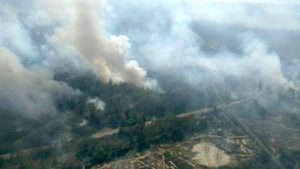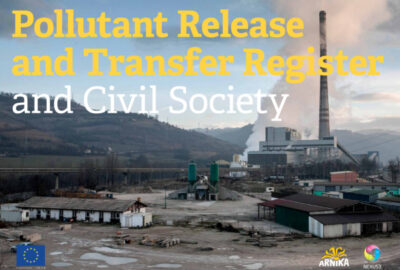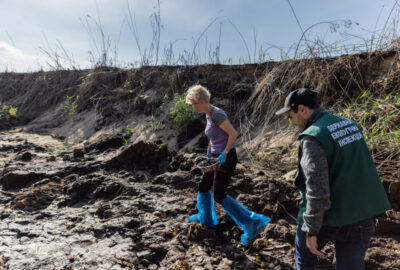The wildfires at the Chernobyl Exclusion Zone started on April 4 and spread to an area of 20 hectares right away. In spite of the great efforts of firefighters, the wildfires completely burned an area of 11 500 hectares by April 26. The fires harmed the forest, the plants, the animals and the environment overall. The fires in Chernobyl caused high levels of air pollution in Kyiv and other areas, reaching the South of Ukraine. The spread of smoke throughout the country was monitored by the Oxygen air monitoring stations. The situation was made worse by fires in the Kyiv and Zhytomyr regions starting at the same time as the Chernobyl fires. In these areas, the fire hasn’t been extinguished yet. What are the consequences of these fires and where does the pollution end?
Fire extinguishing
During the first days, there were 90 firefighters and 18 vehicles, including the air force, deployed to fight the fire. The fires kept re-emerging at several places on the territory of 4 forests in the Exclusion Zone. On April 13, unofficial sources informed that the Chernobyl fire had spread to the Red Forest and had reached the nuclear waste facility Podlesnyi near the nuclear plant itself. Luckily, thanks to rain and active work of firefighters, this fire was successfully extinguished. However, on April 16, the wind blew through the area and the fires started in the Chernobyl Exclusion Zone once again.
Aftermath
The damages caused by this massive fire are still being counted, even though the experts predict that they have already reached dozens of millions of UAH. The representatives of Chernobyl Radiation and Ecological Biosphere Reserve said that small and middle-sized animals were most impacted by the fire – the amphibians, the reptilians and the rodents – because they can’t run from the fire and smoke fast. The assessment of the possible radiological consequences of fires in the Chernobyl zone was made by the Institute for Nuclear Safety and Radiation Protection (IRSN). Thus, the weather conditions that prevailed until April 14 facilitated the transportation of air masses contaminated by fires from the Chernobyl region to Belarus, southern Ukraine, eastern Romania and Bulgaria. However, these air masses have not yet reached European countries. The IRSN also assessed the dosimetric effect of these fires on radiation, and as indicated in the IRSN note, the effect of fires on radioactivity should be negligible.
Smoke without fire
In addition, the Chernobyl fires caused high smoke levels in Kyiv and its surroundings. As of 11:00 on April 17, the air quality index in Kyiv amounted to 338 points, with the norm being 50. According to the website iqair.com, which monitors the level of air quality in the largest cities in the world, the capital of Ukraine had become the most polluted in the world. The Oxygen public monitoring stations throughout Ukraine glowed red, signalling high dust pollution. However, for example, in Zaporizhia and Dnipro, despite the dust concentration being 3-6 times higher, the state monitoring services refuted the claims that the smokescreen is a consequence of forest fires in the Chernobyl Exclusion Zone. Meanwhile, people couldn’t breathe on the street and they recorded the cities filled with smoke on social media. The official reason for the deterioration of air quality with fine dust particles was said to be industrial emissions, intensified by dry weather and strong winds. Although experts from the Ukrainian hydrometeorological centre eventually confirmed the smoke coming from Chernobyl as a possibility.
Maksym Soroka, the scientific and technical expert of the international project “Clean Air for Ukraine”, also believes that the record pollution is caused by the Chernobyl fires: “There are too many factors that come together. This smell of burning, which you can’t confuse with anything, the fine dust and the fact that such huge aerosol mass occurred so locally. Smoke and cinder from Chernobyl fires are a real threat, since the combustion products are toxic and negatively affect the human organism. But there is no radiation threat in them, and there is no reason not to trust official data on this subject.”
Invisible threat
Nevertheless, according to Maksym Soroka, the radiation threat from the Chernobyl fire still exists, but Ukraine will not reap the ecological consequences of this fire now: “At one time, the radionuclides that entered the environment due to natural biochemical and biogeochemical processes, migrated to the soil. This is why the soil is the most radioactive element within the Chernobyl zone. When the vegetation burns higher – and in our case there was a fire of trees, shrubs and grass – the amount of radioniclides in these plants was lower. The main danger from this release was in traditional chemicals, like in a normal fire. But all the radionuclides were located in the upper layer of the soil,” he said.
Control and monitoring
“We must understand that radionuclides as chemical elements can migrate in the environment both geochemically and simply mechanically. In nature, the function of mechanical migration is realized through erosion. The wind spreads the soil particles, and with them – radionuclides. The ecosystem of the Chernobyl zone naturally impeded this distribution. Vegetation, grass and shrubs created a “pillow” of sorts above the surface of the Earth, and the wind alone could not distribute radionuclides. Now, after the fire, there is no forest and vegetation. In fact, the ground got exposed. Many layers of the soil became accessible to erosion processes. The wind will begin to spread combustion products, and then the soil itself will spread them further. Iit is likely that radionuclides can be in this secondary aerosol. It is at this moment that they need to be measured and monitored,” says the expert.
According to the expert, it is necessary to introduce a variety of measures:
- Conduct a comprehensive study to determine the cause of the fire with so many centres and do it publicly.
- Carry out bioremediation activities (artificial planting of plants to increase natural biomass). Invasive Bioremediation – the landing of species that are not typical for a given ecosystem. Forest planting is necessary so as to quickly restore the vegetation cover, which was the main protective mechanism in the Chernobyl zone.
- Financial and technical support of the measures. It would take the nature decades to recover on its own. The sooner we start, the faster we will create a natural protective barrier in this area.
On the other hand, we must assess the risks. Not only Ukraine, but the international community as well need to think about the fact that a huge area of soil contaminated with radionuclides has not been exposed. “This pollution knows no boundaries”, the expert concludes.
NOTE: Officially it is believed the fire was started due to arson. On April 6, the police opened a criminal investigation into the fire in the Exclusion Zone, which is still ongoing. The perpetrators are facing fine, correctional labour for up to two years or imprisonment for up to three years. It is noted that the police have already detained some citizens who may be involved in the arson.







